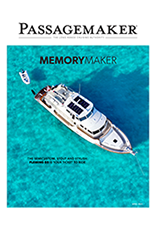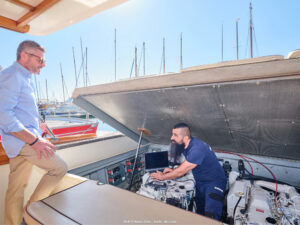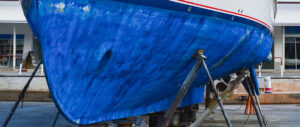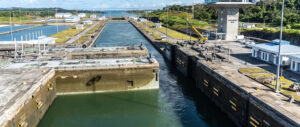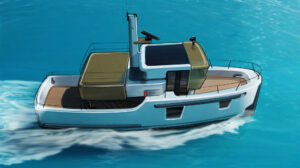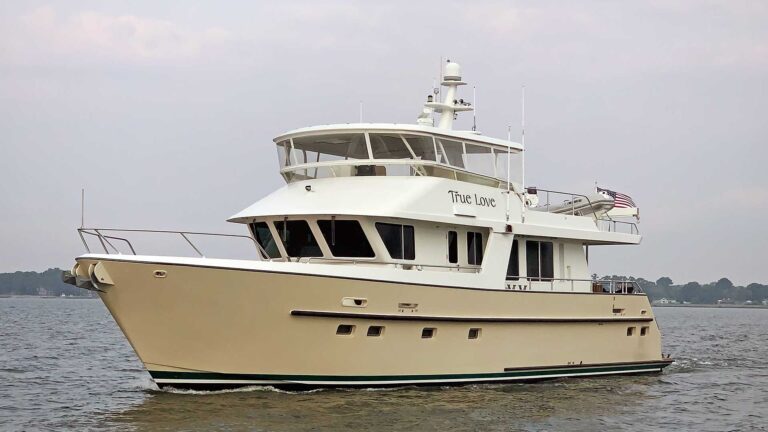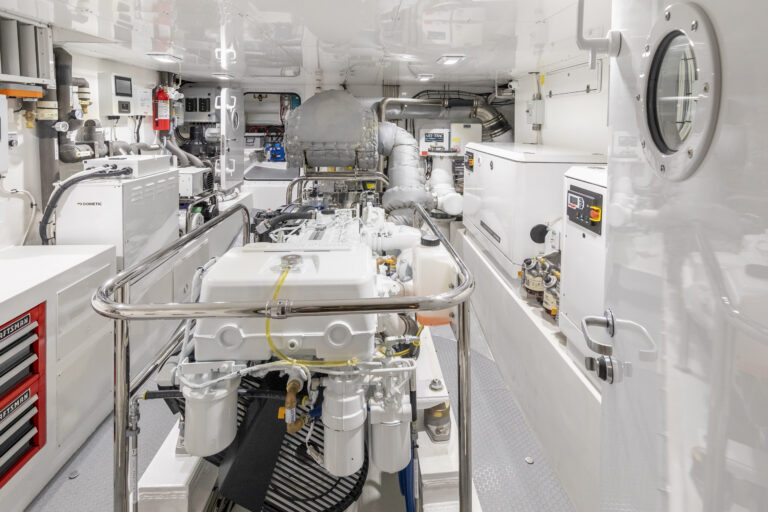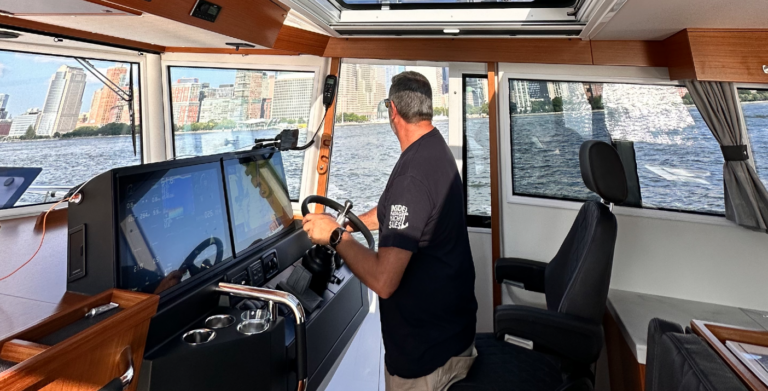
Long ago, shipwrights also were window makers. They cut glass to size, built a wood frame, and put the pieces together solidly with thick beads of caulking, hoping their work would keep the boat dry and draft free.
They built beautiful windows of fine woods. They made rectangular windows, round windows, and oval windows. Some tilted open, while others were sliders. Some, in really old workboats and yachts, were sort of like double-hung windows in houses: they would slide down into a niche in the side wall of the deckhouse.
Today, windows come to boat factories aboard trucks and trains and in shipping containers. Wood is for memories and packing crates. These windows are built of extruded aluminum and tempered glass, and a skilled worker, with the help of modern caulking and sealants, can install one in a couple of minutes. The buyer can count on them to look good, work well for decades, and keep the boat dry and draft free.
To a great extent, boatbuilding factories are parts assembly plants. Aside from the fiberglass hull and deckhouse and interior cabins, most of the components of a modern boat are manufactured elsewhere-from engines and gearboxes to galley sinks and stoves, electrical wiring, plumbing, heating systems, through-hull valves, light fixtures, and windows, too.
Some builders contract with other firms for construction of a boat’s basic building blocks: the plugs from which molds are made and the molds themselves.
I toured a Holland-built boat recently and was impressed with the quality of the interior finish. The owner told me the shipyard contracts with an outside shop that cuts all of the interior teak, using computerguided tooling, and ships the pieces to the builder for assembly. Sort of like buying furniture from IKEA.
It makes sense for boat companies to buy these products from specialists that may make thousands of units a year, rather than gearing up and staffing to produce only a few annually.
I’ve watched boatbuilders at work for years but never paid a lot of attention to the windows and doors they install, other than to see that they appeared to fit and operate properly. I had no idea how windows and doors were built. I had never met a maker of windows and doors.
There are many firms that manufacture windows and doors for the marine industry. To visit one close to home, I flashed my passport at Aldergrove, British Columbia, and drove north to Langley, B.C., and the Diamond/Sea-Glaze plant.
CHANGES COMING
I turned right at McDonald’s, missed the turn onto Gloucester Way, and wandered out into beautiful rural British Columbia. At a T intersection that appeared to go nowhere I wanted, I sought help. I reversed course and soon was in an industrial park, where I found Diamond/Sea-Glaze in a large building along a treelined boulevard.
DSG and predecessor companies have been making windows in British Columbia since 1960. At first, the company built aluminum-framed windows for homes and offices. “Then some guy came in the door wanting a radius RV window [one with curved corners] and asked, ‘Can you make it?'” says Dave Richardson, a partner in today’s company and son of the company’s founder.
“So, then we made RV windows,” he adds. “And then we made marine windows. We have windows and doors for everyone, from a wee boat to an ocean liner.”
Every window is made to order. There is not one “on the shelf ” at DSG.
Today, DSG makes about 25,000 windows and 2,800 doors a year for commercial and pleasure craft. They are shipped to boatbuilders across North America, including C-Dory, Ranger, Nordic Tugs, American Tugs, Sea Sport, Osprey, Parker Boats, and builders of crew boats and oil rigs operating in the Gulf of Mexico. The company ships doors and windows by the container load to Nordhavn in Taiwan. DSG also supplies contractors that build boats for homeland defense in the United States and yards that build tugs, fishing craft, pollution-control vessels, and general-purpose workboats.
This stuff is expensive. One builder of smaller boats estimated he spends $100,000 a month on windows and doors from Diamond/Sea-Glaze.
While nearly all of the windows DSG manufactures are made of aluminum, the company uses steel and stainless steel to fill some orders from commercial builders for heavy-duty work vessels. It makes window frames of bronze for use in some steel structures; aluminum can’t be used because it would react with the steel, with corrosion following.
Like other manufacturers, DSG makes sliding and hinged doors and fixed and opening windows (which come equipped with screens).
And, surprisingly for a large business focusing on production-line boatbuilders, DSG also does a brisk business in one-off manufacture for individuals building or refurbishing boats. We’ll meet a boating couple who ripped old, leaky windows from their trawler-type yacht, used cardboard and pencils to make patterns, and today love the windows and doors that DSG made for them.
I learned later that the company also can move quickly when a boat owner needs to replace a damaged window before continuing a summer cruise.
“We’ll gladly build you just one window,” Dave says.
Dave and his partner, Bill Nohr, told me the company’s challenge is to build its products faster and with improved efficiency. They sense a sharpening of competition, especially from China.
As first steps, they bought a glass-tempering plant, a computer-operated glass-cutting machine, and a full machine shop and installed equipment for dry-powder finishing. They no longer have to wait for someone else to do that work for them.
Next, they plan to introduce production-line changes and add other equipment to increase production by a third with the same crew of 100 workers and to cut the lead time (the time between receiving an order and delivering the product) from about eight weeks to four weeks or less. They will be following the example of industrial giants, including Toyota, which is noted for efficient and speedy production lines, and the Boeing Co., which has slashed the hours it takes to build jetliners.
FROM THE TOP
First stop in a tour of Diamond/Sea-Glaze is the engineering office, where patterns and plans are turned into specifications lists and building instructions on computers with drafting software. Full-scale drawings of each window and door roll out of a huge printer. All relevant paperwork accompanies each window or door as it moves through production, assembly, painting, and shipping.
The basic raw materials are simple: sheets of plate glass and stacks of aluminum sheets. Other materials include sealing and caulking, weather stripping, paint, dry-powder finishes, and fasteners (DSG dedicates one mezzanine-level floor to the storage of thousands and thousands of fasteners).
It’s a sprawling factory. The DSG building covers 80,000 square feet, and the firm now uses nearly all of the space. It’s crowded with equipment for molding, bending, and cutting and with assembly areas where glass and metal come together and windows are created.
Despite the potential for mess-saw debris, aluminum fragments, glass, and the like-the place was clean. We encountered several sweepers hard at work as we toured the building.
Two aluminum alloys are used: 6063, which extrudes well and has a fine finished surface, and 6061, a structural alloy noted for its strength.
The concept of extrusion may be unfamiliar to many. Some suggest it’s like squeezing toothpaste out of the tube. The paste assumes the shape of the open end of the tube as pressure is applied. That end normally is round, and the toothpaste comes out round. If it were another shape, rectangular or triangular, the paste would come out in those shapes.
Extrusion involves using high pressure to shove hot aluminum through a die (the open end of the toothpaste tube) to create the complex shape of a window or door frame. The extrusion, in a contiguous piece, will contain all of the grooves and fittings needed to hold the window components, including tabs for securing the window to a side wall and sections for holding glass plate and screens, weather stripping, and trim. If you look at a single length of extrusion, it may be hard to tell what in the world it is.
Aluminum is extruded to create the specified shape and styling for door and window frames to match the design of each yacht builder. Dave said DSG has 500 extrusion dies and can build windows that fit side walls ranging in thickness from 1/16 inch to 5 inches.
With specifications in hand, a worker cuts an extrusion to the length needed for a window or door. Using a hydraulic tool that is shaped and sized for a specific product, he swiftly makes the necessary bends. To me, how he accomplishes this is a mystery.
Most boat windows are not square. They may have sloping sides. They have radius corners. They are complex. There’s nothing simple about putting the bends in the proper place and creating the correct angles for each corner. Yet, workers know just how to position the extrusion in the bending tool to make bends of the required radius in the proper places, one after another. They make the job look simple. And they can make windows with square (mitered) corners, too.
Mistakes do happen. “We make a little scrap at times,” Dave says.
Bending complete, the frame is checked with the computer print, and the corners are fastened with screws. Frames typically come in two pieces: one (holding glass) that mounts on the outside of the deckhouse, and a second that forms an inside trim. Screws are driven through the inside piece into the outer section, and the parts are pulled tightly against the wall.
Door frames are bent in the same way, but their corners are welded together.
Builders order a mix of hinged and sliding doors, depending on the design of the boat. To make sliders track smoothly and easily, DSG uses UHMW (ultrahighmolecular- weight polyethylene) strips in the sill. Hard and black, UHMW will stand up to years of abuse, and you’ll never get the bump-bump-bump of flattened wheels or the heavy drag of worn and misaligned sliding surfaces. If you want to understand how tough the material is, look over the side of nearly any fairly new boat, and you’ll see rub strakes made of UHMW.
NO STONES HERE
DSG buys ordinary window glass and uses heat tempering to make it safe for use in boat windows.
While bending and shaping of aluminum is basically hand work (aided by machines), glass cutting is fully automated for production-line boats.
Specifications for standard yacht products are stored in a computer. The operator loads the appropriate cutting program and adds details, such as the thickness of the glass.
Glass is stacked vertically alongside the large cutting table. The table’s surface is padded and perforated with small holes through which air is driven. The air tends to lift the glass slightly, easing the operator’s efforts in moving the plate.
As I watched, the operator, with a nonchalant flick of his wrist, tipped a piece of glass about 8 feet square so that it fell toward the padded surface. I probably wasn’t the first visitor to suffer a mild panic attack, fearing the glass was going to break. It didn’t.
With the plate lined up, the cutting head zipped one way and then the other and soon had scored 15 rectangular pieces of glass to fill an order from a single builder. The head returned to each piece and cut the appropriate curve or radius at the corners.
In the good old days, Dave explains, all glass was cut by hand. Today, hand cutting is required only for custom jobs.
After cutting, edges are smoothed, and the glass is cleaned. Then it moves into the tempering machine, where heat makes the glass seven times stronger and changes its structure so that it will break into small granules and not dangerous shards.
Tempering requires temperatures of about 600°C. The “cooking time” depends on glass thickness. The piece I watched disappear into the oven on a moving belt was about 5/8 inch thick and required about 15 minutes of “cooking” (I could see it glowing red-hot) and a cooling period of about the same length.
At DSG, the automated tempering machine is of Italian manufacture, as is the glass-cutting equipment. Before the Italian machine was installed, DSG relied on outside subcontractors for tempering work.
Laminated safety glass is used in some products, as is Lexan, a strong, clear plastic.
Laminated glass is created by building a sandwich of two sheets of glass and an inner layer of clear plastic and pressing them together at a temperature of 70°C in an oil bath. If a window breaks, glass segments remain stuck to the plastic film.
The two automated machines reflect the firm’s need to control production, to eliminate delays and inefficiencies, and to assure on-time availability of the right piece of glass for matching with a frame. It’s likely that more processes will be automated as DSG streamlines production.
“We have to be efficient and able to build at a decent cost to be competitive,” Dave explains.
THE FINAL COAT
Meanwhile, the aluminum window and door frames are treated with Alodyne, a chromic-acid wash that leaves a corrosion-resistant film on the metal. Should a window or door frame be scratched later in life, the aluminum may corrode along the scratch, but the Alodyne treatment will prevent corrosion from spreading under sound paint, Dave explains.
(I know this stuff works. My 1979-model Grand Banks is among the few boats that GB built with aluminum window frames. After 26 years of life, some have been scratched, but the surrounding paint remains sound and still looks good.)
DSG will apply dry-powder coating or “wet” paint; some consider the powder finish harder and more durable in marine use. The process of powder coating was another mystery to me, so it was rewarding to watch the crew apply that kind of finish.
Clean and treated frames and door hardware are suspended from an overhead trolley by wires hooked through screw holes. A worker dressed in hooded coveralls and wearing a full-face breathing mask slides the frames into a brightly lighted booth and picks up a spray gun that looks like an artifact from Star Wars.
The metal carries a negative charge; the powder floating in a light cloud from the spray gun is positively charged and sticks tightly to the aluminum. The dry powder, which consists of finely ground pigment and resin, resembles baby powder. White powder was being applied when we stopped to watch, but other colors are available.
No solvents are used in the powder-coating process, so there are no dangerous fumes. Oversprayed powder can be recovered, reducing waste disposal problems.
After coating every surface, the worker pushes the hanging frames out of the spray area, and another worker shoves them on into an oven. There, they will soak at about 400°F until the powder melts into a smooth, glossy finish.
Finally, with the glass cut and tempered and the metal frames cleaned and coated, all of the parts come together in assembly areas. Glass panels are fit into frames, sealed, and caulked. Door locks and handles are installed.
The checklist is complete. A crew builds wood shipping crates for each order and proudly paints “Made In Canada” on the covers. Soon, trucks arrive, and Diamond/Sea-Glaze windows are on their way to boatbuilders.
THE FINISHED PRODUCT
Many of those wood crates are trucked to the Nordic Tugs factory in an industrial park near Burlington, Washington. I drove over one day to watch the installation of a Diamond/Sea-Glaze window.
I was expected, and Abel Cantu, a Nordic Tugs outfitter, was ready.
A saloon window was resting on the side deck of a 37- foot tug yacht. Abel had his gear: a caulking gun loaded with Sikaflex 296 and a battery-powered screwdriver. Before my arrival, he had tested the window fit and found he needed to smooth a few rough spots on the edges of the window opening.
Abel laid a bead of Sikaflex around the perimeter of the window opening on the outside wall and then picked up the window and shoved it in place. Using only his hands, he pushed on the corners, and the window frame slid tightly against the wall.
Next, he went inside the boat and positioned the inner trim ring on the wall. Screw holes had been drilled at DSG, and Abel quickly set several screws, pulling both sections of the window tightly against the saloon side wall.
With all the screws in place, Abel went back outside and cleaned up the excess Sikaflex that had oozed out around the window frame. Job done.
Recently, another 37-foot tug was involved in a minor collision in a marina, and a DSG window was damaged.
The owners, Jeff Morris and Kate Keener, of Vancouver, B.C., described what happened in a letter to PMM in the December ’06 issue.
“We were tied up to the dock in Pender Harbour, showing off our new boat [Adventure-Us] to some friends, when a Grand Banks 49 sideswiped us. His anchor took out a divot of our fiberglass, wiped off our ship’s bell, and shattered a window.”
They called Nordic Tugs and talked with Dan Hilsinger and Keith Hurst, who called Diamond/Sea- Glaze. In a couple of days, a new window had been delivered and installed, and the boat was able to continue on her maiden cruise.
“Customer service doesn’t get any better than this,” Morris and Keener wrote. Two companies share that credit, obviously.
I recall spotting an older, damaged window at the DSG factory. A replacement was being built, and now I wonder about the story behind it. Another mystery.
OUT WITH THE OLD
Eric and Sherry Muller spend summers cruising on Dolphin, a 1996-model 36-foot Monk. After every window had leaked on a rainy day in Ketchikan, Alaska, and they had tired of mopping up with towels, they decided it was time for an upgrade of windows and doors. Compounding the leak: the aluminum window frames were oxidizing.
Back home, the Bow, Washington, couple removed 11 windows and two doors and replaced them with custom products made by Diamond/Sea-Glaze.
It was a long project. They replaced the windows one year and the doors the following year, performing all of the work themselves.
After removing the old windows, the Mullers fixed cardboard in place over the window openings and drew a pattern of the inside and outside of each window on the cardboard. They drew patterns for the doors and carefully measured the angles at every corner. It took precise measuring to ensure that the bottom of the window in the new sliding door by the helm was at the same level as the bottom of other windows in the saloon.
Knowing Diamond/Sea-Glaze’s reputation for custom work for individuals, they carried the patterns to the DSG factory in British Columbia.
Later, when they drove back to pick up the new windows and doors, the Mullers checked each one against their original patterns and found a perfect fit. Even better, the staff at DSG had completed all of the paperwork required for taking the items back into the United States, and the couple simply displayed the documents as they crossed the border.
The Mullers did not want to remove the handsome teak trim that framed the windows on the inside of the boat, so the new ones were bedded with 3M 4200 sealant and fastened with screws from the outside. It took them a full day to install the first window. They learned quickly, and when they got to the windshields, which had been ordered with 3/8-inch tempered glass for protection against debris that might come aboard in rough water, they installed all three in one day.
Eric said the new windows “popped into place,” with only a little smoothing of the opening required for a perfect fit.
The window frames are anodized, have a natural aluminum color, and require only washing and occasional waxing. The door is painted metal and slides in a DSG track with UMHW glides. Eric is greatly pleased that the poorly fitting old door with its lumpy wheels is long gone.
The project cost the Mullers about $10,000.
His assessment after more cruising in rainy Alaska: “They haven’t leaked.”
